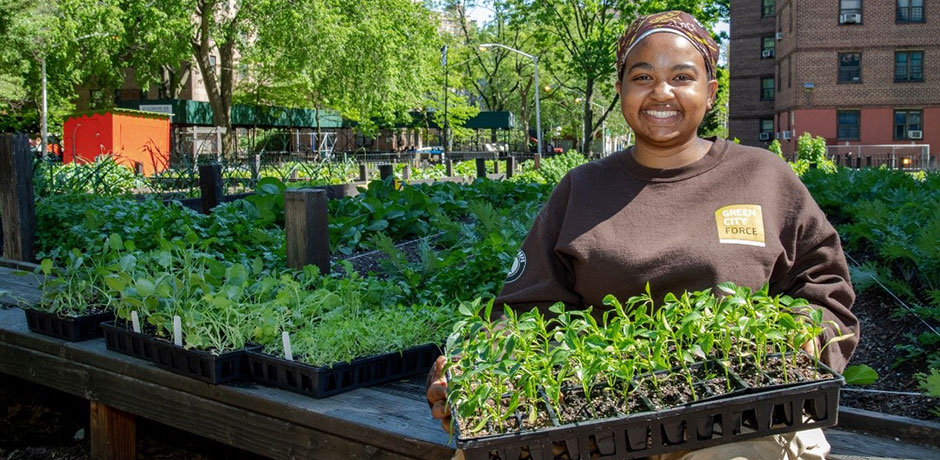The 9-Second Trick For City Blooming
Not known Facts About City Blooming
Table of Contents5 Easy Facts About City Blooming ShownGetting My City Blooming To WorkCity Blooming Things To Know Before You Get ThisMore About City Blooming7 Simple Techniques For City Blooming
Intrigued in expanding food to buy in the City of Chicago? Believing about starting a community yard? Modifications to the Chicago Zoning Ordinance permit agricultural usages like neighborhood yards and city farms in many parts of the city. Below is a checklist of often asked questions pertaining to the policies and regulations that farmers must think about when preparing an urban farming job.
The zoning change does not modify any kind of other codes dealing with composting, building authorizations, purchasing or leasing City possessed residential or commercial property, organization licenses or environmental contamination. There are existing codes that control these concerns and they remain completely effect and may apply to your job. Community gardens are generally possessed or handled by public entities, civic companies or community-based companies and maintained by volunteers.
Urban ranches expand food that is intended to be offered, either on a not-for-profit or for-profit basis. As a result of their business purpose, metropolitan ranches require a company permit. Yes. An area yard is permitted to sell surplus produce that was grown on site if the sales are accessory or subordinate to the garden's main function defined over.
Some Known Questions About City Blooming.
Composting is enabled however only for plant material that is created and made use of on website. The amount of garden compost product can not go beyond 25 cubic lawns at any offered time according to the criteria in 7-28-715 of the City's Municipal Code. Yes. Due to the fact that the dirt at a lot of new garden websites needs amending, compost, dirt, timber chips, or other products can be obtained to construct or improve the expanding space - sustainability.

If a building authorization is needed then the hoophouse will certainly be taken into consideration an accessory building. You can figure out even more about the structure license demands by speaking to the Division of Structures. The 25,000-square-foot size limitation is intended to protect against a single area garden from controling a provided block or interfering with the block's existing property or industrial personality.
The restriction does not use to gardens found in Public Open Room (POS) areas. Can there be more than one area garden that is 25,000 square feet on a single block? Fencing is not needed, nonetheless, gardens that have big car parking locations might be required to install secure fencing or other landscape design attributes.
Getting The City Blooming To Work
B1 & B2 areas require that all commercial usage activities be conducted inside. Is fencing needed for metropolitan farms? Fencings may be called for, along with landscaping and testing, for certain car park locations and outside work or storage locations depending on location and the specific task taking location.
Yes. Urban ranches require structure licenses and zoning approvals before construction. Various other forms of city evaluation might be needed depending upon certain frameworks, activities, dimension, landscaping, licensing, public heath and stormwater administration concerns. Much of these needs are determined in the job style or permitting procedure, nonetheless, the candidate may be responsible to independently recognize specific licenses or allows that might be needed.
Yes. The kind of certificate is identified by what is happening at the website. The Division of Business Affairs and Consumer Defense can assist figure More hints out the particular type of business permit that's required. Yes. Off street vehicle parking is required for many business projects in Chicago. The needed variety of auto parking areas is based upon the number of staff members working with website and not the square footage of the expanding space.
About City Blooming

Yes. A metropolitan ranch can market garden compost product generated on site, nevertheless, the procedure has to abide by the guidelines in 7-28-715 of the Chicago Municipal Code. Yes. Aquaponic systems are permitted inside your home on metropolitan ranches in many zoning areas. However, a zoning testimonial and building license is needed in order to install structures or systems and an organization certificate is called for as described above.
Up to five hives or colonies of honey may be kept as an accessory use. Beekeepers should register with the Illinois Division of Farming. For additional information concerning the recommended zoning amendment you may speak to the Division of Housing and Economic Development, Bureau of Preparation and Zoning at 312.744.8563.
Farming in cities and city locations A metropolitan ranch in Chicago. Urban agriculture refers to numerous methods of growing. https://myanimelist.net/profile/cityblooming, processing, and distributing food in metropolitan areas. The term likewise relates to the area activities of animal husbandry, tank farming, beekeeping, and cultivation in an urban context. Urban agriculture is distinguished from peri-urban agriculture, which happens in backwoods beside residential areas.
Some Known Questions About City Blooming.
, that seek to create social networks started on a common values of nature and neighborhood holism. These networks can develop by means of formal institutional assistance, ending up being incorporated into local town planning as a "transition town" movement for lasting urban growth.
The much more direct access to fresh vegetable, fruit, and meat items that may be know via city farming can enhance food security and food safety while decreasing food miles, bring about reduced greenhouse gas emissions, therefore contributing to climate modification mitigation. Several of the initial proof of metropolitan farming originates from Mesopotamia.